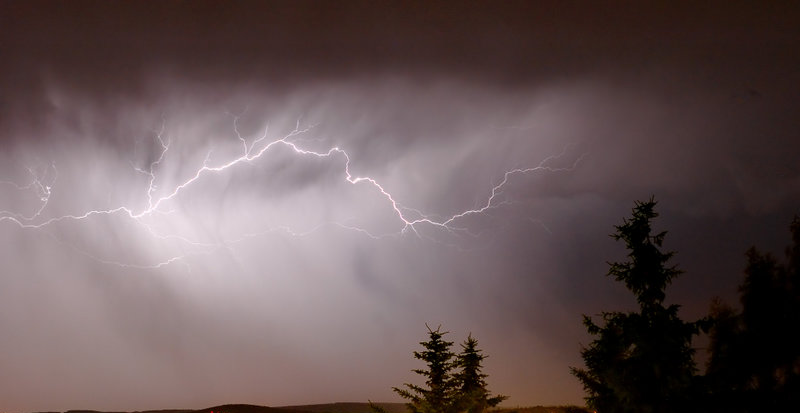“I think of nature as an unlimited broadcasting station, through which God speaks to us every hour, if we will only tune in.”
– George Washington Carver (1864-1943)
When facing one of nature’s emergencies, a hiker’s best defense is a combination of level-headedness and the knowledge and skill with which to act decisively.
Forest Fire
In places such as Australia and the southwest of the United States, bush (or forest) fires are a regular occurrence between late spring and early Fall on an almost annual basis. If you are hiking in fire-prone regions, you need to be aware of the necessary precautions and evacuation strategies.
Before Leaving Home
- Check the weather forecast before setting out. Avoid any high fire danger areas when soaring temperatures and strong winds are prevalent.
- Leave details of your proposed route and schedule with someone you trust. Be sure to contact them upon your return.
Bushfire at Captain Creek central Queensland Australia (photo from Wikimedia Commons).
What to do if caught in a forest fire?
- Be Aware: If a bush fire starts in your vicinity, chances are you will smell and hear it before you see any flames.
- Stay Calm: Take a moment to weigh up your options.
- Assess the Situation: Note the direction of the wind, which indicates the direction in which the fire will be most rapidly moving. Take note of your surrounding terrain, correlating your position on the ground with that on your map. Identify the best possible evacuation route and move swiftly.
- Firebreaks: If the fire is upon you, head immediately for any natural firebreaks such as lakes, rivers, large clearings or gullies.
- Defensive Measures: If you make it to a dry firebreak, wet a shirt and bandana and put them over your head and mouth respectively. Lie face down on the ground. This will help reduce any potential damage to your respiratory system due to smoke inhalation.
Soda Creek Burn, Washington | Pacific Northwest Trail, 2011.
Lightning
When it comes to hiking in areas that are prone to electrical storms, there are three main points to remember:
- Plan ahead.
- Be cognizant of any changes in weather conditions.
- Know what to do if you are caught in a storm.
Precautions
- Forecast: Check the weather forecast before setting out. More often than not problems can be avoided simply by modifying one’s itinerary according to the short-range forecast.
- Research: Review notes and/or maps of your proposed route, identifying areas such as exposed ridges and hilltops which are particularly vulnerable to lightning strikes. Plan to avoid such areas during the time of day when electrical storms are most likely to occur. Check for possible descent routes in case of an emergency.
- Awareness: Whilst hiking, be cognizant of any changes in the weather. Forecasts can sometimes be wrong.
- Danger Sign: If the hairs on your body are standing up, that means that electricity is in the air. In other words, time to get your skates on and exit stage left/right.
- 30/30 Rule: Count the seconds between when you first spot lightning and when you hear thunder. If it is less than 30, take action immediately. Once you have heard the last rumbling of thunder, to ensure the storm has passed, wait for another 30 minutes before continuing on your way.

Photo from Wikimedia Commons.
Caught in the Storm
If descent is not an option and the storm is upon you:
- Location, Location: Keep away from lone trees or rocks.
- Avoid Metal Items: Set aside any metal items such as hiking poles, ice axe or pack frames which can act as conductors in case you are struck.
- Avoid Water: Lakes, tarns, heavily soaked ground and small depressions in which water may pool quickly during a heavy downpour.
- Avoid rock overhangs and the mouths of caves: This is a good one to remember because it’s not so obvious. Lightning can “bridge” the gap between the rock above you and the ground below you by passing through any object that happens to be in it’ way……….in this case, a wet and soon-to-be very sorry hiker.
- Assume the Position: Crouch on an insulating material such as your sleeping mat or frameless backpack. Tuck your chin down on your chest. Your hands and bum should be off the ground. The goal is to minimize contact with the ground and make yourself as small as possible.
Storm approaching | Waterton Lake, Canada | Beginning of the Continental Divide Trail, 2012.
- In the Forest: If you are in a forest or bush area during an electrical storm, don’t take shelter directly under tall trees. Better to position yourself amongst low-lying bushes.
- In a Group: If you are hiking in a group, spread out to minimize the chance of multiple victims from the same strike.
First Aid
- Seek immediate attention: If you have phone service, call emergency assistance.
- Assess the situation: If there is an ongoing risk of lightning and/or the victim is in a high-risk area (e.g. highest point on a ridge or next to an isolated tree), consider moving them to a safer spot.
- CPR: If the victim is knocked unconscious and does not appear to be breathing, CPR should be administered immediately. It is safe to touch them as victims do not carry any electrical charge after being struck by lightning.
- Check for Injuries: If the victim is breathing, check for any injuries such as burns and broken bones. If you suspect that neck or spinal damage has been sustained, stabilize the victim’s head and treat for shock.
Avalanche
When hiking in snowbound, mountainous terrain hikers need to be aware of the dangers posed by avalanches. Any snow slope, no matter what its gradient, has the potential to slide. The steeper the angle, the greater the probability. Avalanches most commonly occur on slopes ranging from 30 to 45 degrees.
For a general overview of avalanche basics, click on the following link from Princeton University’s excellent Outdoor Action website. Three points to consider :
Mount Baker Wilderness | Pacific Northwest Trail, 2011.
- Education: Before embarking on a trip, educate yourself in regards to the different types of avalanches, warning signs, necessary precautions and what to do in the event of a worst-case scenario.
- Up-to-date Information: Before setting out, check the latest weather forecast and consult with local authorities as to the current snow conditions and potentially hazardous areas.
- Recognition & Adaptability: Theory is all well and good, but unless you can translate what you have learned out in the field, all your acquired knowledge will be for nothing. Keep your wits about you at all times, try to avoid walking in close proximity (be it above or at the base) to cliffs and bluffs and never be afraid to turn around and/or look for an alternative route if your chosen path appears to be overly dangerous.
Flash Flood
The sudden nature of flash floods is what constitutes their greatest threat.
- Research: Check the weather forecast before setting out. Review notes and maps, identifying areas (e.g. gorges, canyons, valley bottoms, stream beds, lake beds, river washes, and basins) that are prone to flash flooding during sudden heavy rainfall.

Riding out a Flash Flood in Hop Valley | Zion National Park, UT, USA, 2013.
- Choosing a Campsite: If heavy rain is a possibility, avoid making camp in the above-mentioned places. Identify high water marks and/or flood debris level and search out a campsite above these points.
- Patience: During flash flooding, find higher ground and stay put. Water levels will go down. Be patient. Flash floods usually last less than six hours.